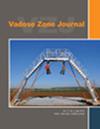Heat transport from atmosphere through the subsurface to drinking‐water supply pipes
IF 2.8
3区 地球科学
Q3 ENVIRONMENTAL SCIENCES
引用次数: 0
Abstract
Abstract Drinking‐water quality in supply pipe networks can be negatively affected by high temperatures during hot summer months due to detrimental bacteria encountering ideal conditions for growth. Thus, water suppliers are interested in estimating the temperature in their distribution networks. We investigate both experimentally and by numerical simulation the heat and water transport from ground surface into the subsurface, (i.e., above drinking‐water pipes). We consider the meteorological forcing functions by a sophisticated approach to model the boundary conditions for the heat balance at the soil–atmosphere interface. From August to December 2020, soil temperatures and soil moisture were measured dependent on soil type, land‐use cover, and weather data at a pilot site, constructed specifically for this purpose at the University of Stuttgart with polyethylene and cast‐iron pipes installed under typical in situ conditions. We included this interface condition at the atmosphere–subsurface boundary into an integrated non‐isothermal, variably saturated (Richards') the numerical simulator DuMu x 3. This allowed, after calibration, to match measured soil temperatures with ±2°C accuracy. The land‐use cover influenced the soil temperature in 1.5 m more than the soil material used for back‐filling the trench above the pipe.热从大气通过地下输送到饮用水供应管道
在炎热的夏季,由于有害细菌遇到理想的生长条件,供水管网中的饮用水质量可能受到高温的负面影响。因此,供水商对估计其分配网络中的温度很感兴趣。我们通过实验和数值模拟研究了从地表到地下(即饮用水管道上方)的热量和水分输送。我们考虑了气象强迫函数,用一种复杂的方法来模拟土壤-大气界面热平衡的边界条件。从2020年8月到12月,根据土壤类型、土地利用覆盖和天气数据,在斯图加特大学专门为此目的建造的一个试验点测量了土壤温度和土壤湿度,在典型的原位条件下安装了聚乙烯和铸铁管。我们将大气-地下边界的这一界面条件纳入了一个集成的非等温、变饱和(Richards’)数值模拟器DuMu x 3。这允许,校准后,以±2°C的精度匹配测量的土壤温度。土地利用覆盖对1.5 m范围内土壤温度的影响大于管道上方回填沟所使用的土壤材料。
本文章由计算机程序翻译,如有差异,请以英文原文为准。
求助全文
约1分钟内获得全文
求助全文
来源期刊

Vadose Zone Journal
环境科学-环境科学
CiteScore
5.60
自引率
7.10%
发文量
61
审稿时长
3.8 months
期刊介绍:
Vadose Zone Journal is a unique publication outlet for interdisciplinary research and assessment of the vadose zone, the portion of the Critical Zone that comprises the Earth’s critical living surface down to groundwater. It is a peer-reviewed, international journal publishing reviews, original research, and special sections across a wide range of disciplines. Vadose Zone Journal reports fundamental and applied research from disciplinary and multidisciplinary investigations, including assessment and policy analyses, of the mostly unsaturated zone between the soil surface and the groundwater table. The goal is to disseminate information to facilitate science-based decision-making and sustainable management of the vadose zone. Examples of topic areas suitable for VZJ are variably saturated fluid flow, heat and solute transport in granular and fractured media, flow processes in the capillary fringe at or near the water table, water table management, regional and global climate change impacts on the vadose zone, carbon sequestration, design and performance of waste disposal facilities, long-term stewardship of contaminated sites in the vadose zone, biogeochemical transformation processes, microbial processes in shallow and deep formations, bioremediation, and the fate and transport of radionuclides, inorganic and organic chemicals, colloids, viruses, and microorganisms. Articles in VZJ also address yet-to-be-resolved issues, such as how to quantify heterogeneity of subsurface processes and properties, and how to couple physical, chemical, and biological processes across a range of spatial scales from the molecular to the global.
 求助内容:
求助内容: 应助结果提醒方式:
应助结果提醒方式:


